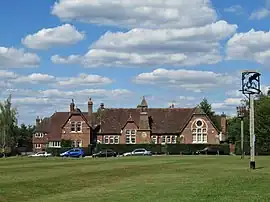Hawkhurst Moor
Hawkhurst Moor is a village green and sports field at Hawkhurst in Kent.[1] It was the centre of the original village and lies to the south of the modern town, with the A229 road running across the area.[2] A cricket ground on the Moor was the venue for two first-class cricket matches in the 1820s.
 Part of the village green with the Victorian primary school building | |||||
| Ground information | |||||
|---|---|---|---|---|---|
| Location | Hawkhurst, Kent | ||||
| Coordinates | 51.039°N 0.504°E | ||||
| Establishment | by 1788 | ||||
| Last used | 1927 | ||||
| Team information | |||||
| |||||
| As of 6 September 2010 Source: CricketArchive | |||||

The Moor was originally an area of common land. The right to hold an annual fair was held on the green was established by a deed granted by Edward II in 1311, and a fair was held annually until the 19th century. A market was also held on the green until the 17th century and the area is used today for community events.[3][4] The area is designated a conservation area, one of four in Hawkhurst.[4][5] The village church, the Eight Bells public house, parish council office, a former brewery, the original Victorian village school, closed in 2003, and a former post office and stores building surround the village green area.[5][6][7] To the east, the King George V playing field was established in 1937 and is the modern sports ground.[8]
Cricket
The cricket ground, which was located on the village green, is first known to have been used in 1788 by Hawkhurst Cricket Club, although the club is known to have played cricket from 1727 and it is probable that this took place on the Moor.[8] The club was considered one of the most influential in Kent at the beginning of the 19th century and challenged the County XI a number of times.[8] During the 1820s the ground was the venue for a number of matches considered notable, and in 1825 and 1826 two matches which are now considered to hold first-class status were held there.[8][9]
Both of these matches were organised by the Hawkhurst club and featured Kent sides playing against Sussex XIs. In each year Kent sides also played Sussex at the Royal New Ground in Brighton as part of the same arrangement.[10] These were the first inter-county matches played since the end of the Napoleonic Wars. During the 1830s the ground was used for at least one match by the Gentlemen of Kent amateur side against Marylebone Cricket Club.[8]
The ground remained in use until 1927, although the buildings to the north of the green had to be shuttered during play due to the small size of the ground.[8] The main road running to the east of the green became too busy and was widened, reducing the area usable for cricket.[11] The cricket club moved to play on a local school playing field from 1928 to 1936, but returned to the Moor in 1937, using the newly opened King George V playing field across the main road from the original ground.[8]
References
- The Moor, Hawkhurst Parish Council. Retrieved 2024-04-14.
- Milton 1979, p. 7.
- Everleigh, p. 12.
- Everleigh, p. 10.
- Neighbourhood Plan, p. 11.
- Everleigh, p. 13.
- Eight Bells, Maidstone and Mid-Kent Campaign for Real Ale. Retrieved 2023-04-14.
- Milton 1992, pp. 22–23.
- Hawkhurst Moor, Hawkhurst, CricketArchive. Retrieved 2017-12-17. (subscription required)
- Carlaw, p. 38.
- Milton 2020, p. 213.
Bibliography
- Carlaw D (2020) Kent County Cricketers A to Z. Part One: 1806–1914 (revised edition), pp. 8–12. (Available online at the Association of Cricket Statisticians and Historians. Retrieved 2020-12-21.)
- Everleigh N (1999) Hawkhurst Conservation Areas Appraisal. Tunbridge Wells: Tunbridge Wells Borough Council. (Available online. Retrieved 2024-04-14.)</ref>
- Neighbourhood Plan 2016—2033, Hawkhurst Parish Council, 2020. (Available online. Retrieved 2024-04-14.)</ref>
- Milton H (1979) Kent cricket grounds, in The Cricket Statistician, no. 28, December 1979, pp. 2–10. (Available online at The Association of Cricket Statisticians and Historians. Retrieved 2023-04-14.)
- Milton H (1992) Cricket Grounds of Kent. Nottingham: The Association of Cricket Statisticians and Historians. (Available online. Retrieved 2022-04-04.)
- Milton H (2020) Kent County Cricket Grounds. Woking: Pitch Publishing. ISBN 978-1-78531-661-6